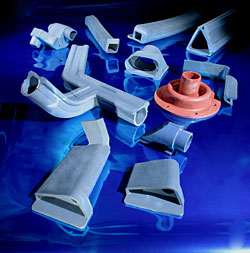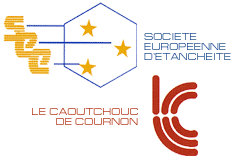 Fabric-backed moulded parts Fabric-backed moulded parts
These parts are characterised in their composition by the assembly of at least two elements, sometimes more, allowing the following combinations:
- rubber textile
- rubber textile + metal
- rubber textile + composite
- rubber + PTFE or FEP coating
Materials
The choice of materials is determined by our laboratory as a function of the desired applications.
The criteria to be taken into account are:
- the temperature
- the abrasion
- repeated bending
- creep (compression set)
- tear
- the pressure of use (inflatable joints)
- the fluids present
The elastomers used are generally of the type Silicone 50 D5 – 52 D5 – 53 D5.
As well as any other type of elastomer as a function of the environment (temperature, contact fluid, etc.) for example: fluorinated silicone, nitrile and neoprene.
If phosphoric esters are present, we recommend Ethylene Propylene.
Textiles
- tear resistance
- fire resistance
- liveliness
- slip
- abrasion
The families of textiles used are:
- polyesters
- glasses
- Nomex®
- Kevlar®
- ceramics
- conductors
We have referenced products available:
| Polyesters: |
2273L |
Liveliness |
| |
2274M |
Abrasion |
| Glasses: |
2254S |
thin Fabric High temperature 180°C |
| |
2240B |
thick Fabric High Temperature 180°C |
| |
2265D |
Braiding for fire proof barrier. Resistance 15 min. 1100°C |
| |
2266E |
Thick fabric, fire proof barrier. Resistance 15 min. 1100°C |
| NOMEX®: |
2250J |
Fire resistance up to 250°C |
| KEVLAR®: |
2489S |
Fire resistance up to300°C, very high mechanical characteristics and flexibility maintained. |
| Ceramics: |
2391Y |
Very good temperature resistance, 1200°C continuous exposure, low flexibility, limited mechanical strength. |
| Conductors: |
2396D |
surface fabric enabling electrical conductivity, electromagnetic armour (EMI). |
Other strengthening materials:
- Metal (stainless steel, aluminium and lead for nuclear applications).
- Composite (epoxy glass, epoxy carbon, the choice of material depends on the vulcanisation temperature).
NB: These fabrics may be used in combination; for example, an immersed fabric 2273L and a surface fabric 2274M.
The fabrics used are generally square fabrics (i.e. same number of warp and weft threads) but they may be supplied in the form of jersey or other weave.
|

